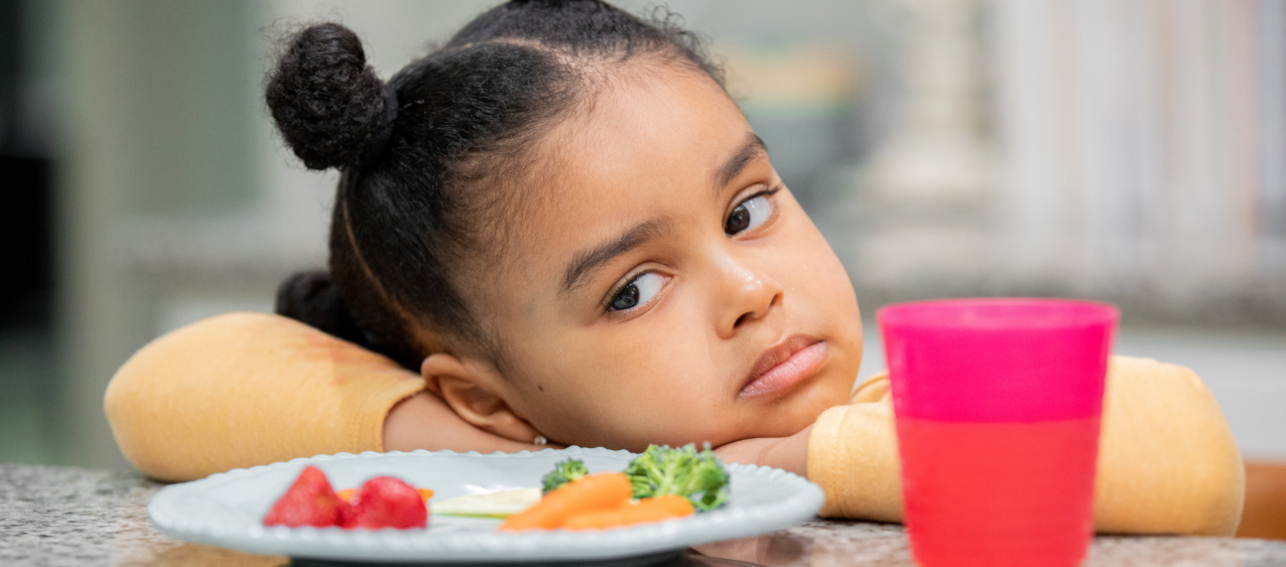Your child comes to you one day and says, “I want to eat vegetarian.” What do you do? If the rest of your family doesn’t already eat a vegetarian diet, this can be a big announcement.
Vegetarian and other plant-based diets are still in the minority in children and teens, but kids are open to exploring these diets more now than ever before. It’s estimated that 5-6% of children and teens are vegetarian, and 1-2% are vegan.
In my experience as a dietitian, and as a vegetarian myself, I often work with families transitioning to alternative diets.
TYPES OF PLANT-BASED DIETS
If you’re trying to support a child who is interested in following a vegetarian eating pattern, make sure to understand what their definition of vegetarianism is. The primary categories of plant-based diets are:
- Lacto-ovo-vegetarian: Does not eat meat, poultry, fish and shellfish, or any foods derived from these (broth, gravy). Does allow dairy (lacto) products and eggs (ovo).
- Lacto-vegetarian: Does not eat meat, poultry, fish, shellfish and eggs, or any foods derived from these. Does consume dairy products.
- Ovo-vegetarian: Does not eat meat, poultry, fish, shellfish and dairy products, or any foods derived from these. Does eat eggs.
- Vegan: The most restrictive plant-based diet. Does not eat any animal products (meat, poultry, fish, shellfish, dairy products, eggs) or any animal byproducts, including gelatin and honey.
- Pescatarian: A lacto-ovo-vegetarian diet that also allows fish and/or shellfish.
Sometimes people use the term semi-vegetarian or flexitarian. These diets usually exclude red meat but allow poultry or fish/shellfish from time to time.
FIRST, DISCUSS YOUR CHILD’S REASONS
Interest in alternative diets can form at any age, but I see it emerge most often during the early teen years. If your child wants to try a plant-based diet, I recommend starting off by talking about the reasons behind that choice and what it means to them.
Is it because of concerns related to health, the environment, natural resources, or animal rights? Is it because they just don’t like meat, or are there social or ethical considerations behind their decision?
There are many factors that may influence a person’s decision to pursue a plant-based diet. Children sometimes surprise their parents with well-researched and well-thought-out positions. Try to verify the sources of their information if you can. Of note, if your child’s desire to adopt a vegetarian diet seems to stem from a desire for calorie restriction or weight control, it is important to contact their pediatrician to discuss this further.
Listening to your child’s motivations allows you to understand where they’re coming from. This is an important step in starting good conversations about how to make dietary changes work within the context of your family’s life.
HOW TO SUPPORT A CHILD WHO WANTS TO TRY EATING VEGETARIAN
- Be supportive. Early exploration gives kids and teens an opportunity to develop healthy vegetarian/vegan eating habits while under adult supervision and with parental guidance.
- Start slow. Consider sampling vegetarian eating 1-2 days per week (such as “Meatless Mondays”) to give your child a chance to test it out and see if it is something they would like to continue.
- Involve your child. This is their journey, and it will require teamwork. Enlist your child’s help in planning meals, making the grocery list, grocery shopping and cooking meals.
- Prepare meals where meat can be an “add-in” that a child can simply forego or substitute. Examples could be:
- Vegetable stir-fry with chicken and tofu available on the side
- Protein-rich spaghetti (made with chickpeas, quinoa or lentils) with meatballs served separately
- Tacos/burritos with both meat and beans as options
- Engage the whole family. Even if other family members don’t intend to make diet changes, incorporate vegetarian meals into your usual repertoire that everyone can enjoy. Possibilities could be black bean soup, baked pasta dishes, Indian curry or vegetarian chili.
- Try new recipes. Search out recipes together with your child. Trying new foods helps kids learn to enjoy other types of cuisine and expand their dietary horizons.
- Plan ahead. Be thoughtful about meals in advance, especially at restaurants and at school, where the selection of vegetarian entrees may be limited.
VEGETARIAN NUTRITION TIPS
Eating healthfully as a vegetarian is about more than just not eating meat, and it is important that your child understands that. It’s about eating balanced meals filled with nutrient-rich plant foods, like whole grains, beans, lentils, fruits, vegetables, nuts and seeds. A diet comprised only of cheese, bread, cookies, noodles, Doritos, French fries and soda may be vegetarian, but it does not promote health.
According to the Academy of Nutrition and Dietetics, appropriately planned vegetarian and vegan diets are healthful, nutritionally adequate, and offer health benefits in the prevention and treatment of certain diseases. With proper planning and education, they are considered appropriate for all stages of the life cycle. Your child can certainly grow and thrive on a plant-based diet. In fact, some of the healthiest, longest-living populations in the world (concentrated in geographical regions known as “Blue Zones”) follow vegetarian diets.
Here are some nutrition tips for a vegetarian diet:
- Be aware of nutrients of concern within a vegetarian/vegan diet. Plant-based diets can be low in iron, calcium, vitamin D, zinc, vitamin B12 and/or omega-3 fatty acids. However, there are plenty of plant-based sources of these nutrients, and nutritional deficiencies can be readily avoided with intentional planning and education. Dietary supplements can also be used if necessary, but the human body absorbs nutrients best from real food.
- Be aware of times of rapid growth in your child to ensure they can keep on top of their calorie needs and nutrient intake. Plant-based diets are usually lower in calories and higher in fiber, which can make a child feel full before they meet their body’s energy needs.
- Keep your child’s doctor informed of a change to a plant-based diet, and ask for their guidance in making the switch. Sometimes lab tests are needed to assess for nutritional adequacy.
- Consider working with a dietitian to help the transition be successful. A dietitian can help individualize a plant-based lifestyle to your child’s needs and give you the tools to make a vegetarian lifestyle both creative and satisfying.
POSITIVE IMPACTS OF PLANT-BASED DIETS
If your first reaction to this situation is, “Oh no, how am I going to manage this?”, try to think beyond the immediate moment. Consider how this change in diet could contribute to your child’s health long-term. Research has found that children and adolescents who follow a vegetarian eating pattern tend to consume more fruits and vegetables, less saturated fat, and fewer sweets and salty snacks compared to their non-vegetarian peers.
Plant-based diets are also rich in nutrients such as fiber, vitamin A, vitamin C, vitamin E and phytochemicals, which the average American diet is inadequate in. The Academy of Nutrition and Dietetics cites that vegetarians and vegans are at reduced risk of certain health conditions, including ischemic heart disease, type 2 diabetes, hypertension, certain types of cancer, and obesity.
Experimenting with a plant-based diet can help kids and teens become more mindful about their food choices and where their food comes from. It also provides an opportunity to develop important life skills such as meal planning and cooking, regardless of whether they opt to continue with the diet into adulthood.
RESOURCES: COOKBOOKS AND WEBSITES
Remember, support often begins at home. Here are a few resources I like using for vegetarian inspiration:
- The 30-Minute Vegetarian Cookbook: 100 Healthy, Delicious Meals for Busy People by Lisa Turner
- Munchie Madness: Vegetarian Meals for Teens by Dorothy Bates, Bobbie Hinman, and Robert Oser
- Better than Peanut Butter and Jelly: Quick Vegetarian Meals that Your Kid Will Love! by Marty Mattare and Wendy Muldawer
- Oh My Veggies
- Oh She Glows






